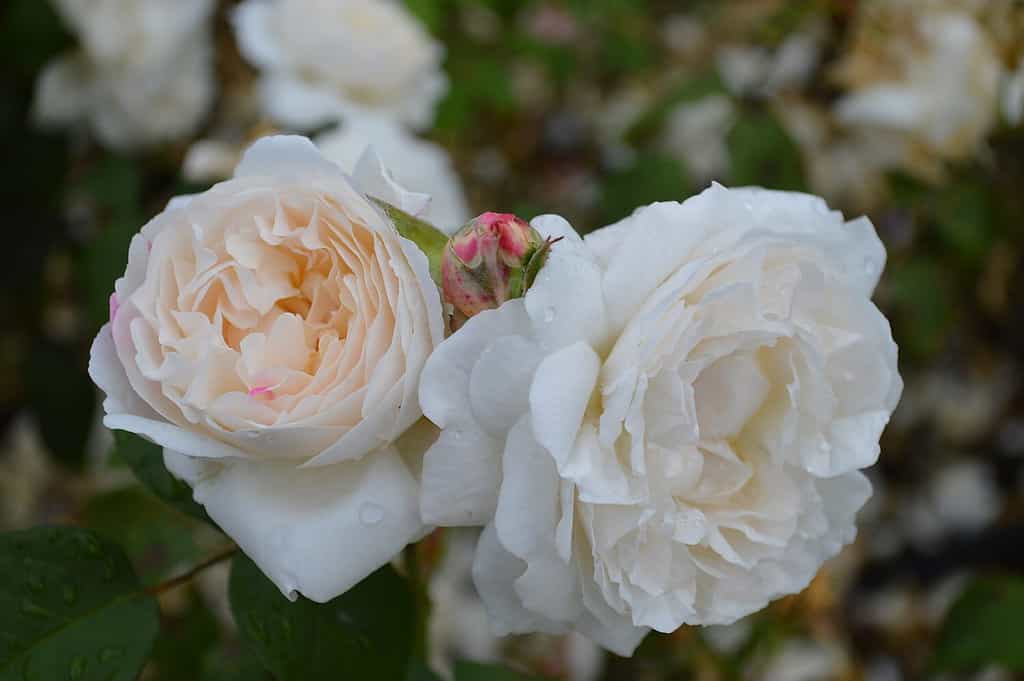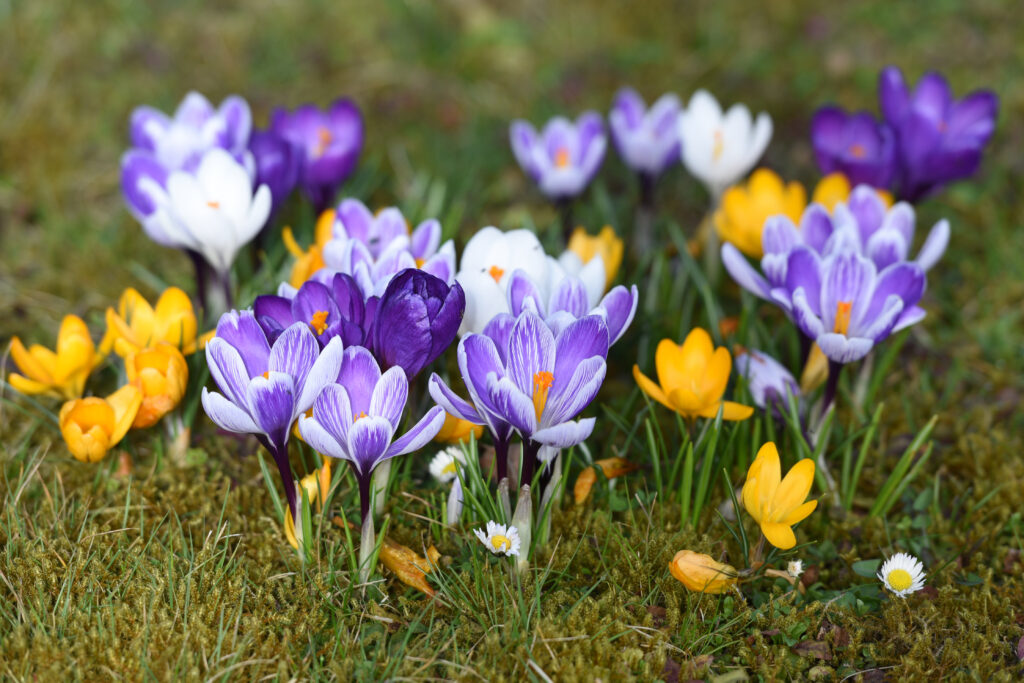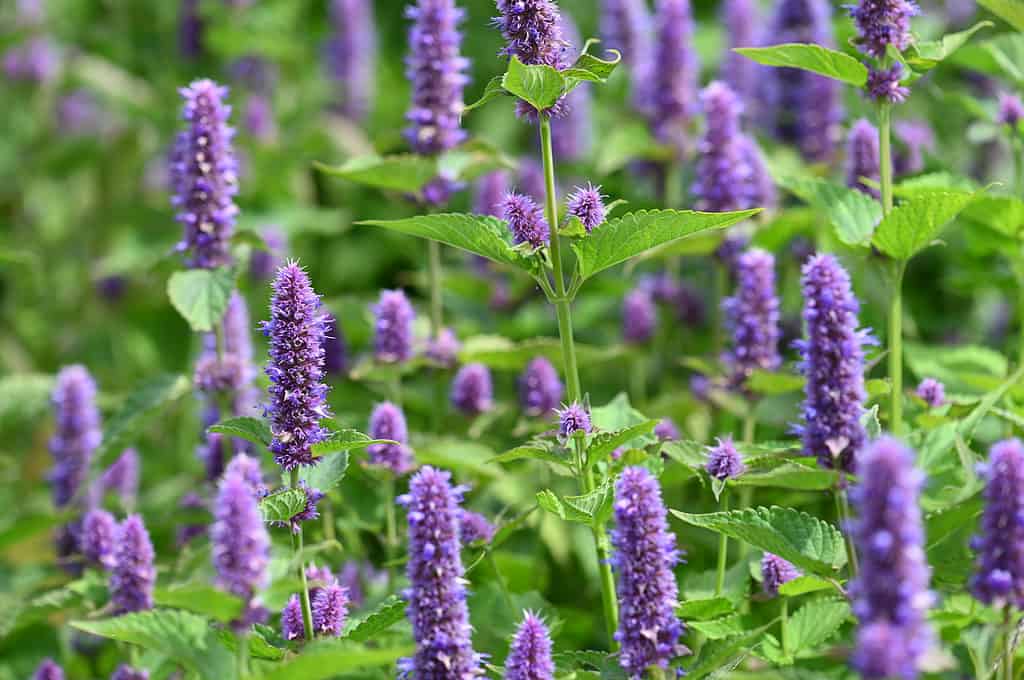The Bible is rich in symbolism, often seen through objects, colors, numbers, language, and actions. The Holy Book references many common objects, including flowers, which often represent various virtues and significant events, sometimes even symbolizing Jesus himself.
The Bible also speaks about flowers in general, with metaphorical verses, such as Isaiah 40:6-8:
“All flesh is grass, and all its loveliness is like the flower of the field. The grass withers, the flower fades, because the breath of the Lord blows upon it; surely the people are grass. The grass withers, the flower fades, but the word of our God stands forever.”
From plants and animals to food and household objects, the Bible uses common items to teach lessons, give instruction, inspire, uplift, and place significance. Discover the symbolism of these four flowers in the Bible, including advice on how to care for them and tips on how to use them in worship.
1. Rose

White roses symbolize the purity and charity of the Virgin Mary.
©Joe Kuis/Shutterstock.com
The rose is a woody perennial flowering plant with over 300 species and numerous color variations. They are famous for their delicate unfurling petals and notable for their elegant appearance. In the Bible, roses are symbols of love, joy, and beauty. And different rose colors can have separate meanings. Red roses symbolize the shedding of Christ’s blood, while white roses reference the purity and charity of the Virgin Mary.
One of the most memorable verses about roses is Song of Solomon 2:1, “I am a rose of Sharon.” Solomon’s bride was the speaker in the verse. She is saying she is a flower that has bloomed in season.
Meaning: love, joy, beauty, purity, sacrifice
How to use roses in worship:
While roses can signify Earthly love, they also symbolize God’s love at work in people’s lives. And it’s no secret that the atmosphere of a place of worship can change by the presence of different flowers. Roses are perfect for decorating church weddings, as they celebrate the love and beauty of two souls coming together. Red and white roses would also be appropriate for Easter services.
Tips for caring for roses:
- Give them at least six hours of full morning sun
- They need well-drained, slightly acidic, nutrient-rich soil
- Only water the root zone
- Plant them in a spot with good drainage
- Fertilize them regularly
- Water them every morning during the growing season
2. Lily

Easter Lilies are perfect for Easter Sunday services. These flowers are often referenced in the Bible.
©Peter Krisch/Shutterstock.com
The lily is an herbaceous flowering plant with large, showy flowers. These are the most elegant flowers in the bible. We often think of lilies as bright white, like the Easter lily or Madonna lily, but they can come in many bright colors. Lilies are significant in many cultures and literature throughout the world, from authors such as William Blake, William Shakespeare, and Charlotte Bronte. But they are also mentioned in the Bible dozens of times, with one of the most famous being Mathew 6:28-29, “Consider the lilies of the field, how they grow: they neither toil nor spin; and yet I say to you that even Solomon in all his glory was not arrayed like one of these.”
Like white roses, lilies are synonymous with purity and innocence, but they also represent love, beauty, resurrection, new life, and the promise of eternal life. They represent both the Virgin Mary and Christ’s resurrection, as well as used metaphorically to talk about God’s love and care for us.
Meaning: purity, innocence, love, peace, beauty, resurrection, new life, and the promise of eternal life
How to use lilies in worship:
Because lilies represent Christ’s purity and innocence, lilies are acceptable for many church occasions, especially Easter and Good Friday services. Placing bouquets of white lilies around foyers, chapels, and auditoriums will bring a sense of peace and joy to your congregation.
Tips for caring for lilies:
- Lilies grow best in hardiness zones four through nine
- They need lots of sun, at least six to eight hours of direct sunlight each day
- Plant them in a spot that is the first to dry out after a good rain
- To further encourage good drainage, mix the soil with compost, manure, and leaf mold
- Don’t cut back the leaves until they turn brown in the fall
- Apply a layer of compost and mulch each spring
3. Crocus

Crocuses feature natural insulation that allows them to fight off the cold weather.
©Spitzi-Foto/Shutterstock.com
The crocus is a genus of seasonal flowering plants that produce small bright yellow, purple, or white flowers during the spring. Crocus flowers belong to the iris family and are notable for their sweet, honey-like fragrance. Not only were these flowers in the bible, but ancient Egyptians used them as herbal remedies. Manuscripts dating back to 1500 BCE cite them for their helpfulness with joint pain.
In the Bible, the crocus is a sign of spring and new life. When the rain comes and the crocus blooms, it’s a time for the land and its people to rejoice. Isaiah 35:1-2 is one of the most notable passages in the bible about crocuses, “The desert and the parched land will be glad; the wilderness will rejoice and blossom. Like the crocus, it will burst into bloom; it will rejoice greatly and shout for joy.” Crocus flowers can also symbolize rebirth, innocence, joy, youth, and cheerfulness. This flower embodies the Virgin Mary, symbolizing her purity, innocence, and her calling to bring forth sacred new life. On the other hand, it also represents Christ and his resurrection, which allowed sinners to become reborn and pure in God’s eyes.
Meaning: spring, new life, rebirth, innocence, joy, youth, cheerfulness, and purity
How to use crocus flowers in worship:
The crocus flower’s rich fragrance and bold colors are perfect for any spring ceremony or service. While they are common during Easter Sunday, you could add arrangements to many springtime events. The purple crocus is also great for celebrating a church member’s years of service and dedication.
Tips for caring for crocus flowers:
- While they grow in partial sun, the crocus does best when it gets at least six hours of direct sunlight.
- These flowers will rot in compacted and soggy soil, so be sure to plant them in a well-draining site.
- They need to experience a period of cold weather, so plant them in the fall if you want spring blossoms.
- Water them very well after planting
- You should consider planting crocus flowers in sprawling lawns where they can form carpets or large beds.
4. Hyssop

Hyssop belongs to the mint family and the leaves are used in cooking and herbal medicine.
©iStock.com/BethAmber
The hyssop is a bushy aromatic plant from the mint family native to the Middle East and Southern Europe. People can use the minty leaves for cooking and herbal medicine, while its twigs played heavily in ancient Jewish rites of purification. Before delivering the people from Egypt, the Lord commanded the Jewish nation to use hyssop and animal blood for protection, “Take a bunch of hyssop, dip it into the blood in the basin and put some of the blood on the top and on both sides of the doorframe (Exodus 12:22).”
Hyssops symbolize sacrifice, repentance, humility, purity, cleansing, and health. Due to its ceremonial cleansing in Leviticus, hyssop best represents the washing clean of sins. It also spread the Passover lamb’s blood and purified lepers of their disease.
Meaning: sacrifice, repentance, humility, cleansing, purification, and health
How to use hyssop in worship:
You can use hyssops in fresh floral arrangements or dry them. These flowers bloom from mid-summer to late autumn, so they are perfect for late summer and fall services and events. However, hyssop is typically added to bouquets for a fresh and herbaceous scent.
Tips for caring for hyssop:
- While these flowers are drought-tolerant, you should consistently water them until established
- It grows best in hardiness zones four through nine
- Fertilize hyssop with a balanced liquid fertilizer
- Cut back the dead leaves and stems during the spring
- Replace the plants every four to five years, as they decrease in quality as they age
A Recap of 4 Flowers in the Bible
| Number | Flowers in the Bible | Symbolism | Verses |
|---|---|---|---|
| #1 | Rose | Love, joy, beauty, purity, sacrifice | Song of Solomon 2:1Isaiah 35:1 |
| #2 | Lily | Purity, innocence, love, peace, beauty, resurrection, new life | Mathew 6:28-29Hosea 14:5Song of Solomon 5:13; 2:1Luke 12:27-28 |
| #3 | Crocus | Spring, new life, rebirth, innocence, joy, youth, cheerfulness, purity | Isaiah 35:1-2 |
| #4 | Hyssop | Sacrifice, repentance, humility, cleansing, purification, health | Exodus 12:22Leviticus 14:1-7Hebrews 9:19-22Numbers 19:17-20 |
Thank you for reading! Have some feedback for us? Contact the AZ Animals editorial team.








